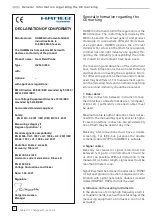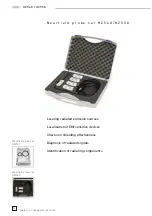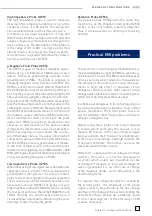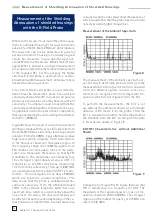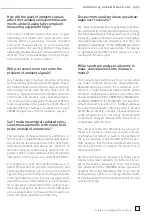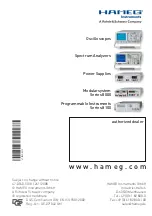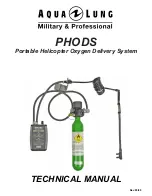
6
Subject to change without notice
General informations
G e n e r a l i n f o r m a t i o n s
General informations
Electromagnetic compatibility continues to be an
important issue. The main goal is to make circuitry
„quieter“ and more sustainable to meet tough
EMC regulations. Even with the best PCB layout
techniques and the most substantial decoupling,
at the speeds of today’s designs, radiation from
boards and the consequent noise impinging on
PCBs is becoming a growing problem that will
not go away.
In order to minimize the cost of test to comply
with EMC regulations, it is recommended that
a “Pre-Compliance” phase in product develop-
ment first to be conducted. This phase would
use a spectrum analyzer such as the HM501 or
HM550 in conjunction with HZ50 or HZ550 near
field sniffer probes, to inspect for emission and
leakage, isolate the source, redesign and correct
the problem and then retest.
Once the product appears electromagnetically
“quiet”, it is submitted to the compliance certifi-
cation laboratory. This should save the expense
for much of the test time, since the submitted unit
has already been pretested. Typically, the test time
and money saved should represent many times the
purchase price of the spectrum analyzer.
HZ540 and HZ550
EMI-Near Field Probe Sets
The HZ50/550 are the ideal toolkits for the
investigation of RF electromagnetic fields. They
are indispensable for EMI pre-compliance testing
during product development, prior to third party
testing. The sets include resp. 5 hand-held
probes with built-in pre-amplifier covering the
frequency range from
<
1MHz to approx. 000
MHz.
The probes of the basic set HZ50 include one
magnetic field probe, one electric field probe,
and a high impedance probe. In addition to it the
HZ550 features an optional µ-magnetic field probe
and a passive radiation probe. All probe outputs
are matched to the 50 Ohm inputs of spectrum
analyzers or RF-receivers.
The probes are designed to assist in providing
quick identification of signal sources. It can be
used to diagnose emissions from circuit boards,
integrated circuits, PC board edge runs, ground
plane currents, ribbon cables, corner seams and
similar interference sources.
Signal feed is via a 1.m SMA to N-connector
cable. When used in conjuction with a spectrum
analyzer or a measuring receiver, the probes can
be used to locate and qualify EMI sources, as well
as evaluate EMC problems at the breadboard and
prototype level. They enable the user to evaluate
radiated fields and perform shield effectiveness
comparisons. Mechanical screening performance
and immunity tests on cables and components are
easily performed.
Electric-Field Probe HZ 551
The electric field (mono-pole) probe has the
highest sensitivity of all probes in the HZ50/550
sets. It can be used to check shielding and per-
form pre-compliance testing on a comparative
basis. It is even sensitive enough to be used as
an antenna for radio or TV reception. With this
probe the entire radiation from a circuit or an
equipment under test can be measured. It is
used, for example, to determine the effectiveness
of shielding measures. The effect of suppression
„fixes“ can be quickly verified. The probe may
be used to perform relative measurements for
certification tests. This makes it possible to
apply remedial suppression measures so that
any requalification results will be positive. In
addition, pre-testing for certification tests may be
performed so that no surprises are encountered
during the certification tests.
Magnetic-Field Probe HZ 552
The radiated signals detected with the E-Field
probe can be further investigated by menas of
the magnetic field probe HZ55.The magnetic
probe incorporates a high degree of rejection
of both stray and direct electric fields, and
provides far greater repeatability than with
conventional field probes. Measurements
can be made on the very near field area that
is close to components or radiation sources.
It is especially suited to locate emission “hot
spots” on PCBs and cables. One can investigate
shields for “leaking” areas and cables or wires
for conducted interference. With this probe, the
entire effectiveness of filters can be measured
by measuring the RFI which is conducted along
cables that leave the equipment and may influ-
ence the total radiation.









